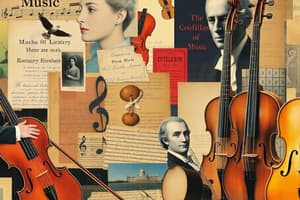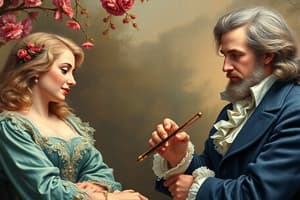Podcast
Questions and Answers
Which of the following accurately describes the relationship between recitative and aria in the Romantic period?
Which of the following accurately describes the relationship between recitative and aria in the Romantic period?
- Both forms were primarily accompanied by basso continuo.
- They gradually merged into a unified style known as the 'unending melody.' (correct)
- The two forms were distinctly separated with clear differences.
- The arias became more complex while recitatives became simpler.
What characterizes the Romantic Concerto compared to earlier forms?
What characterizes the Romantic Concerto compared to earlier forms?
- It featured less demanding writing for the solo instrument.
- It strictly adhered to classical forms and structures.
- It was primarily composed for piano and string quartet.
- It incorporated more symphonic elements and virtuosic writing. (correct)
In which context is the strophic form primarily used?
In which context is the strophic form primarily used?
- For complex orchestral compositions that require varied melodies.
- In folk songs where simplicity and memorability are important. (correct)
- For art songs emphasizing emotional depth and lyrical variation.
- In opera scenes that require dramatic contrasts in musical themes.
What distinguishes the through-composed form from the strophic form?
What distinguishes the through-composed form from the strophic form?
What is a defining feature of a song cycle in the Romantic period?
What is a defining feature of a song cycle in the Romantic period?
What distinguishes opera as a theatrical genre during the Romantic period?
What distinguishes opera as a theatrical genre during the Romantic period?
Which statement about the developmental characteristics of the sonata in the Early Romantic Period is true?
Which statement about the developmental characteristics of the sonata in the Early Romantic Period is true?
How does the structure of the strophic form benefit song composition?
How does the structure of the strophic form benefit song composition?
What best characterizes the chamber music of the Romantic period?
What best characterizes the chamber music of the Romantic period?
What is a common feature of the Romantic Concerto?
What is a common feature of the Romantic Concerto?
What role does the unending melody play in Wagner's music drama?
What role does the unending melody play in Wagner's music drama?
Which element is essential for a piece to be classified as a song cycle in the Romantic period?
Which element is essential for a piece to be classified as a song cycle in the Romantic period?
What defines the ballet as a musical form during the Romantic period?
What defines the ballet as a musical form during the Romantic period?
How does the through-composed form differ from the strophic form?
How does the through-composed form differ from the strophic form?
Flashcards
Romantic Opera
Romantic Opera
A highly varied musical drama, emphasizing acting, dancing, and colorful costumes, representative of national styles, continuing Classical Italian traditions.
Romantic Concerto
Romantic Concerto
A free-form concerto, featuring demanding virtuosity for solo instruments, with a more symphonic character.
Strophic Form (Song)
Strophic Form (Song)
A song structure using the same music for each stanza.
Through-Composed Form (Song)
Through-Composed Form (Song)
Signup and view all the flashcards
Song Cycle
Song Cycle
Signup and view all the flashcards
Recitative and Aria in Romantic Period
Recitative and Aria in Romantic Period
Signup and view all the flashcards
Opera in the Romantic Period
Opera in the Romantic Period
Signup and view all the flashcards
Romantic Sonata
Romantic Sonata
Signup and view all the flashcards
Chamber Music in Romantic Period
Chamber Music in Romantic Period
Signup and view all the flashcards
Romantic Concerto Characteristics
Romantic Concerto Characteristics
Signup and view all the flashcards
Ballet in Romantic Period
Ballet in Romantic Period
Signup and view all the flashcards
Suite in Romantic Period
Suite in Romantic Period
Signup and view all the flashcards
Strophic Song Form
Strophic Song Form
Signup and view all the flashcards
Through-Composed Song Form
Through-Composed Song Form
Signup and view all the flashcards
What is a Song Cycle?
What is a Song Cycle?
Signup and view all the flashcards
Study Notes
Musical Forms of the Romantic Period
- Vocal Forms
- Recitative and Aria: Basso continuo accompaniment wasn't used in the Romantic period; recitative and aria gradually blurred into "unending melody" in Wagner's music dramas.
- Opera: A dramatic musical form with costumes and scenery; popular in France, Germany, and Italy; showcased various national styles, building upon the classical Italian tradition.
Instrumental Forms
-
Sonata: Piano and orchestra sonatas in the early Romantic period resembled classical models.
-
Chamber Music: Romantic chamber music sometimes incorporated programmatic or nationalistic elements.
-
Concerto: Romantic concertos were free-form, demanding virtuoso solo instrument technique, and more symphonic in nature.
-
Ballet: A theatrical form where stories are told through dance, pantomime, and scenery.
-
Suite: A series of movements, sometimes drawn from ballets, based on a central story or theme.
-
Two Song Forms
- Strophic: Uses the same music for each stanza, making it easy to remember, common in folk songs.
- Through-composed: Features different music for each stanza, allowing for better expression of a poem's changing moods.
-
Song Cycle:
- A collection of Romantic art songs, unified by a narrative or musical ideas.
- Example: Schumann's Poet's of Love (1840).
- Romantic composers used song cycles to achieve a combination of music and poetry.
Studying That Suits You
Use AI to generate personalized quizzes and flashcards to suit your learning preferences.




